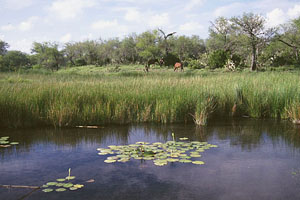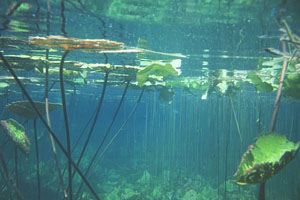Desert Fishes Council
34th Annual Meeting
San Luis Potosí, SLP, México

- El aguaje, Rioverde valley
- Media Luna Spring
El aguaje, Rioverde valley
 |
|
El Aguaje, Rioverde valley. Photo by Juan Miguel Artigas Azas. |
The little creek at El aguaje, near the town of Villa Juarez in the Rioverde valley, is part of the Rioverde fascinating aquatic ecosystem. It has its origin at the close by springs of Puerta del Rio and it is an excellent example of the beautiful and delicate habitats of the Rioverde valley. The species that can be found at the place are: The Poeciilid Poecilia mexicana; The Characinid Astyanax fasciatus; The Goodeid Ataeniobius toweri (endemic and monotypic), The Cyprinodontid Cualac tesselatus (endemic and monotypic), the cichlids Herichthys labridens (endemic form) and H. bartoni (Endemic); the Ictalurid Ictalurus sp. and the ubiquitous Sarotherodon aureus (introduced). The Rioverde valley is a fertile and a poorly exploited area for research purposes.
This trip is intended for DFC participants who have planned to return to their places of origin by Sunday, November 17. The transportation will depart Sunday early morning (8:00 am) from the host hotel and will return around midday (13:00 hrs.)
In the town of Villa Juarez bottled water and refreshments are available, as well as junk food in the town's "tiendas". There is nice scenery for picture taking and an abundance of cactus for those interested in them.
Media Luna Spring
 |
|
Media Luna spring, Photo by Juan Miguel Artigas Azas. |
The Medialuna spring is the biggest of the springs of the marvelous Rioverde valley, which is located some 180 kilometers (112 miles) east from the host hotel by a nice highway. The spring, with crystal clear and thermal waters holds a constant temperature of about 86°F (30°C) and has a total depth of 118 feet (36 m), so don't forget to bring your swimming suits, mask and snorkel for an unforgettable event. The spring hosts 13 species of fish, of which three are introduced and six are endemic to the Rioverde valley, two of those endemic species are monotypic. The species found Medialuna spring are: The Poeciilids Gambusia atrora (introduced); Poecilia latipunctata (Introduced); Poecilia mexicana; The Characinid Astyanax fasciatus; The Goodeid Ataeniobius toweri (endemic and monotypic), The Cyprinodontid Cualac tesselatus (endemic and monotypic), The Cypriniids Dionda mandibularis (endemic) and D. dichroma (endemic); the cichlids Herichthys labridens (endemic form), H. bartoni (Endemic) and H. carpintis (introduced); the Ictalurid Ictalurus sp. and the ubiquitous Sarotherodon aureus (introduced). The Rioverde valley is a fertile and a poorly exploited area for research purposes.
This trip will take the full day, so we have to leave the host hotel early in the morning at 8:00 am to come back home after 7:00 PM. If time allows we will make a stop in another beautiful spring in the Rioverde valley at Puerta del Río (on the way), which shows a different frame with most of the valley species (but only one exotic).
We will have lunch at a restaurant in Rioverde, at Medialuna however, being a popular pic nic place. you can find small "tiendas" with all sorts of junk food and refreshments, as well as some souvenirs. There is nice scenery for picture taking and an abundance of cactus for those interested in them.